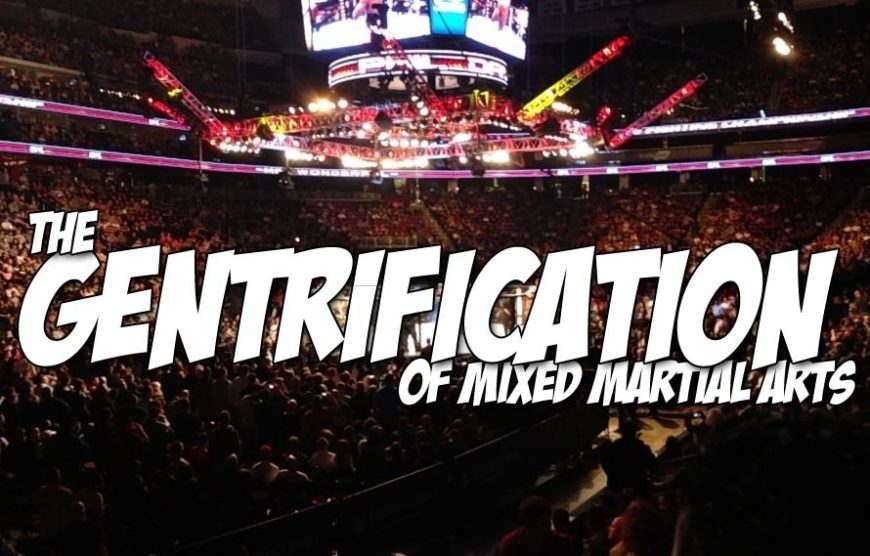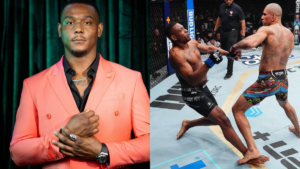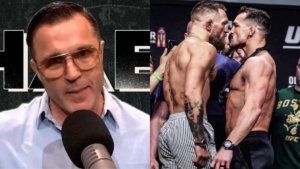When I think of the state of Mixed Martial Arts today it feels like a strange pastiche; an uneven mishmash that is being sold wholesale to audiences who aren’t sure if they are hungry for blood and destruction, sport or spectacle. There are two very important concepts at play, through abstraction they can be broken down into their very essence, which are gentrification and the pursuit of the American Dream.
Mixed Martial Arts and the UFC go hand-in-hand, you cannot have one without the other. They are intrinsically linked together. Their fate became intertwined as soon as the original season of The Ultimate Fighter picked up steam thanks to a strong lead-in from WWE’s Monday Night Raw all of those years ago. This, in and of itself, shows that the savior for this sport that we all know and love today came from athletic theater and its aging fanbase who was trying to grasp at the concept of “the real.” That audience found their “real” within the UFC’s brand of Mixed Martial Arts.
The original concept behind the UFC was not of some noble cause to further Martial Arts, nor did it have anything to do with Bruce Lee and his quest for clarity and cohesion in Martial Arts. Instead it was the vision of the Gracie family to help to build up Gracie Jiu-Jitsu as not just another Martial Art, but the Martial Art for a modern era, the only one that mattered. In a way they were successful, as the term “jiu-jitsu” holds weight throughout the world. No longer do the middle class look towards Billy Blanks and his “aerobic kickboxing” as their way to get fit, but to learning Brazilian Jiu-Jitsu along with doing their MMA-inspired CrossFit routines.
The disconnect between Martial Arts and Mixed Martial Arts could not be more defined than it is now. The term “Martial Arts” has never truly held much weight within the sport of MMA, instead it was a marketing tool, sampling from the tradition and respect that Martial Arts have built up over centuries of existence to help soften the blow of two men in tiny gloves trying to pound each other to a pulp in the ring. There are still many that see the tenuous link between traditional Martial Arts and Mixed Martial Arts, citing techniques and styles which have been folded, battered and beaten into the modern sport of MMA, but the connections are fleeting at best.
I remember back to when I was about nine years old and was enrolled in Kenpo classes, Kenpo itself was a term appropriated by Americans for their own blend of Martial Art that included Chinese, Japanese and Okinawan Martial Arts styles. While the style itself was Americanized, there was still a push for tradition, for the Martial Way to play an important role in the lives of its students. To many the tradition might seem like an obsolete remnant from the past, followed for no other reason than to say that there is tradition involved, but there were important lessons to learn about respect, restraint and responsibility within the obscure term that was the Martial Way.
The concept of the belt was important, not just because of the rank that came with it, but for what it represented. You were to respect your belt as if it were an extension of your sensei, of the dojo and the style itself. Therefore, the belt was never supposed to touch the ground, as a show of respect. Think of it like the American flag, which out of respect you would never throw onto the ground. In our dojo there were metal power boxes that were near the ground and before class, before we were instructed to wear our belts, everyone would rest their belt on the box. In a way, it felt like cheating, as they weren’t supposed to touch the ground, but we were simply finding a place to stow them in the meantime. At the time I had no clue about how much of a misnomer it was for a belt to touch the ground, I needed to use the bathroom and didn’t want to carry it, so I left my neatly-folded belt on the ground, as there was no more room on the power box.
The end result of that was having an additional twenty situps and pushups added to my pre-class routine for disrespecting my belt, my teacher and the dojo itself. It is a lesson that has stuck with me for years, even if at the time I found it to be ridiculous and antiquated. It was a symbol, which can carry a lot of weight with it and carries over into other aspects of life beyond just that symbol. I can’t say the same about some of my adult experiences with Mixed Martial Arts, in part, because MMA is built upon an entirely different set of rules and beliefs.
Mixed Martial Arts is, in very many ways, the gentrification of Martial Arts. It is taking something that someone found flaws in and making it into something different, something that appeals to more people and will make more sense to them. It’s incredibly difficult to make a career out of Martial Arts, not because they aren’t fulfilling or valuable, but because the end goal is not to make money. Outside of smaller tournaments there is very little practical value for most Martial Arts, which means that becoming good at a Martial Art very rarely means that you can turn it into a career. Teaching at a small school won’t make you rich, nor will owning your own dojo, but if you truly love it there is a chance that you will find happiness in it. Maybe you’ll get a lucky break and work in television and film doing stunts or choreographing fights, maybe even acting, but that is rare. The average Martial Artist is not making a lot of money off of it.
Mixed Martial Arts can be sold to people that it is about self-defense or fitness and self-betterment, but the practical application is to make money. MMA is a product. The concept of the dojo doesn’t really exist within MMA, instead there are gyms where you can take various classes in different styles with different coaches. Very rarely will there be belts involved, and if they are in the mix they are ornamental at best. Most of the tradition does not fit the narrative of MMA.
If you wonder why it is very simple; it is the American Dream. The American Dream is predicated on the idea of making money to acquire more things and to live a better life through this money. The American Dream very sharply contrasts with the Martial Way, which is more about self-discovery and co-existing with one’s surroundings than it is to compete with your neighbor for having nicer, more expensive things. We’ve lived through the spawning of the McDojos to “trane” kids to “fight UFC” now and have seen most of them weeded out, which just leaves us where we are now.
The techniques that are used in MMA are almost without real value, they are just leaves on a tree, a small part of the greater whole. Modern MMA has sampled from various Martial Arts and combat sports, proving itself to be a veritable Whitman’s Sampler of a sport. All of the techniques and ideas that can be seen as practical, applying to the sport of MMA directly and cutting out everything else because it has been deemed as pointless at some juncture. This is not, of course, a wholesale concept, as we still see people like Lloyd Irvin work in concepts from traditional Martial Arts, assimilating a code of conduct and a sense of honor as a sales pitch for those suffering from spiritual malaise, then mutilating those beliefs in the name of chasing the American Dream. We’ve all seen how well that worked out for Lloyd Irvin.
In a way, Martial Arts have been bastardized by the sport of Mixed Martial Arts, used as a justification for the brutality, a way to mask the reality of it. Without the term “Martial Arts” the product itself would be too brutal, too dangerous and unfit for general consumption. The idea of “ultimate fighting” is that of a bloodsport, but everyone has at least a general grasp on the tradition and honor that comes with the term Martial Arts. I’d like to think that Bruce Lee, someone who grappled with his fame and all that came to him from Martial Arts while trying to stay true to the origins of the Martial Way which helped to shape him and set him on the right path in life, would look at modern day MMA not in a positive light, but one of disgust. Not because of the basic concepts, as the concept of two men battling against each other and only using the most effective techniques was something that he believes in, but because of how Martial Arts were packaged and turned into a product.
I am not implying that there is anything wrong with MMA, quite the opposite in fact. I’ve been a fan of MMA for as long as I can remember, as ordering old Pancrase and SHOOTO events became a part of my routine along with my K-1 and Japanese pro-wrestling purchases back in the late 90’s. MMA has simply grown a lot since the 90’s and no longer resembles what those early fights in Japan were. It has been adapted, molded and assimilated into a more American sport, which comes with both pros and cons, but for better or worse, it is its own sport now. It might be time to leave traditional Martial Arts out of the equation, as the term “Martial Arts” makes about as much sense in MMA as calling the NFL “Football.”









